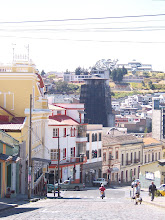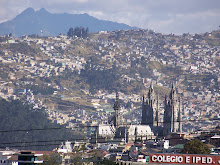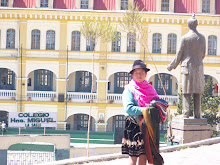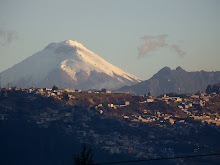After my slow start in Ecuador, life has somehow sped up to a blur – and what with living it, I have lost track of documenting it. It would be impossible to fit all that´s transpired into one blog, but below I’ve included a few weekend highlights.
THE BULL FIGHT
For independence holidays in Ecuador – which there are many, because they celebrate the independence of every city – it´s customary to host a bullfight. During Riobamba´s independence day in November, my friend Shelly and I packed up our sunscreen and headed to the open-air Plaza de Toros. Toreros – or bullfighters – were already strutting around outside the stadium, their gold-embroidered attire glittering in the afternoon sun. Shelly and I made our way inside to the cement bleachers, huddling against the wind. Like everything in Ecuador, the show started late, but after a brief parade of the toreros and matadors, they stabbed the first bull and loosed it into the arena. It streaked through the stadium in demonic frenzy, scattering the toreros, who dove for their lives behind wooden platforms. Finally one pink-clad torero stepped forward, snapping his cape with theatrical confidence. He began leading the beast in graceful circle inches from his own body. “Ole!” shouted the audience in glee each time the bull touched the cape. Whenever the bull seemed to decide chasing a cape wasn´t worth his while after all, someone would promptly ride up on horseback to stab the bull again. Bucking and snorting in fury, the enraged bull would do his utmost to flip the horse over by with his horns before pursuing the torero once more.
Bullfighting is a curious mix of art and brutality. Perhaps it is still accepted only because it is thought of as a tradition. As someone who had never really witnessed live violence, I could appreciate the skill but could hardly watch this poor bull loose more and more blood, leaving a trail in the dust behind him as he began to stumble doggedly after the torero. When the bull finally tumbled to the ground from exhaustion and blood loss, a matador walked up and finished the poor beast off.
I was amazed, though, at how quickly a person can become desensitized to the violence. Six more bulls appeared to fight, and after each I seemed to think less and less about the bull. I still feared for the toreros, though. Several times one would be knocked to the ground, causing the bull to lower his horns and charge at the helpless fighter. Each time, someone dragged the torero out of the way at the last possible second, but it still left my heart thundering at seeing (what seemed to me, anyway) the near-death of another human being. I have to say, watching a bullfight made me appreciate the virtues more peaceful sports. I suppose the excitement of the bull arena has its points, but I think I would be just as content with a nice round of golf.
IN THE COUNTRY
Because the maid in my house is around more than almost any other person, I’ve gotten to know her fairly over my two months here. Carmita is an ambitious woman, who teaches embroidery classes and takes online education courses in addition to being a single mom and taking care of my family’s house all day. She only has one day off per week – Sunday – in which she visits her parents in the country. One day she asked me to go with her and her seven-year-old son, David.
It is incredible how lifestyles in Ecuador within just a few miles. When you drive a few miles in the States, you can often witness a change in affluence. In Ecuador, it’s more like a change in time period. When I visited Carmita’s parents it seemed I went back at least 100 years.
We took a bus out from Riobamba, landing in the nearby pueblo Chambo, after which we clambered into the back of a local’s truck that was going our direction. We bumped along the choppy dirt roads, green mountains rising around us and water rushing in streams nearby. It was deliciously refreshing after the noise and dryness of the city. I could hear birds instead of the blare of sirens and car horns.
Her parents’ house was small, with about two rooms and a separate kitchen outside; and it didn’t appear to have any running water. The door was so low that a tall gringa like me needed to duck to go inside. The venerable-looking mother, an indigenous woman who still speaks Quichua (the language of the Incas), was lighting the wood fire for lunch. She welcomed me with open arms, as did Carmita’s father, and then they showed me around the back yard. It was a miniature Eden, dense with tropical fruit trees, corn, peas, and beans. Rabbits and guinea pigs ran freely, and David helped me catch baby rabbits to hold. Later David and I were assigned the task of catching a rabbit to eat, which I have to say is no easy task – though between the two of us we finally did.
The day passed in lazy peacefulness. I kept an eye on one of the toddler grandchildren while Carmita’s mother cooked over the fire in black cauldrons. Later we all went for a walk up the nearby hill to look out over the river to distant Riobamba and to craggy, snow-capped Chimborazo still further. I went home that day feeling incredibly at peace. Carmita invited me to go with them any time, and I have no doubt that I will go again.
BAÑOS
About two hours from Riobamba is one of the most touristy places in Ecuador: Baños. It derives its name from its natural hot springs (or “baths”), which entice tourists from all over Ecuador for a relaxing soak. It also affords all sorts of other activities, from rafting to hiking cycling. One of the sketchier operations is bungee jumping, in which a guide will find a bridge, tie on the rope, and then tell you to jump. I decided to skip that one.
For people like me who are on a budget, biking is the best choice. On almost every block, you can rent a bike for about five dollars and then head down the mountain roads towards the jungle city of Puyo. They also provide you with a map and a helmet that looks like it could survive a small atomic explosion. That´s probably a good thing, considering you can´t count on fully functioning brakes or inflated tires.
Early on Saturday morning, my friends Shelly and Steffi and I donned those helmets, looking like we were ready for the apocalypse, and hopped on rental bikes. Though they gave me the biggest bike they had, it was still far too small, and consequently my chin got well acquainted with my knees. I must have looked rather special. Needless to say, it was worth it. Half the time we barely had to pedal, and instead cruised downhill while the foliage grew more and more jungly. Colorful orchids exploded in color against spears of banana leaves, kept fresh by the perpetual mist of the nearby cascades. We explored the waterfalls by venturing onto the swinging bridges and cable cars that stretched over nearby valleys.
Despite the popularity of this bike ride, there weren’t any bike lanes to speak of, and pedaling frantically through a dark tunnel with cars zooming up behind was harrowing to say the least. Like many things in Ecuador, you say, “I think this isn´t a good idea,” and then you go ahead and do it anyway. (Because really, that´s often what I say when I cross the street). But what a treat it was to see a completely different climate in Ecuador – and only two hours from where I live! Like the population, the landscape can change in a matter of miles. It is the most diverse place I have ever lived, and for that reason Ecuador will always keep me guessing.
Showing posts with label Ecuador teaching travel. Show all posts
Showing posts with label Ecuador teaching travel. Show all posts
Sunday, December 13, 2009
Wednesday, September 30, 2009
On Culture Shock...
Culture shock. It´s one of those slippery terms that can mean just about anything, from somebody serving you a steaming platter of ox tail to having your cab driver weave down the street backwards in an attempt to find your house (both of which have happened, needless to say). It can be other things too, like the acceptance of a perpetually volatile political climate. Televised news affirms this daily, with its incessant newscasts of the Indigenous marching the street, yelling and rolling tires and tossing burning branches, all in protest of the government´s policies on water. Culture shock is mostly just the daily things, though, like remembering to greet everybody with an ¨Hola¨ and a touching of cheeks. Getting beyond the greeting, of course, is an adventure in itself, and mix-ups are more or less constant for new speakers like me. The words ¨city¨ and ¨careful¨ sounded very similar to me, and when my host mother in Quito would admonish me to be careful, I would attempt to agree by saying, “I´m a city,” and step cheerfully out the door. I´m sure that was little comfort to my host mom.
“Cuidad,” or “careful,” is perhaps a word I need to take to heart. My first day in Riobamba on Monday, I popped on my running shoes, ready to take advantage of the safer environment that Riobamba affords (more so than Quito, anyway). But what Riobamba lacks in thieves and frenzied traffic, it more than makes up for in potholes. I was about six blocks away from my house when I stepped in one of these little hazards, twisting my ankle so badly I could hardly limp out of the street. Sitting down and trying desperately not to faint, I was obliged to eventually hop in a car of an Ecuadorian family, who seemed rather excited to be rescuing a lame foreigner in distress. I promptly called my host mom upon returning, trying to explain what happened over the phone, but I used the wrong word for pothole, saying instead, “Violetta, I have little problem. I ran and stepped in golf hole. Now ankle sick.” Probably wondering what on earth I was doing on a golf green, my host mom came home and whisked me off to the doctor, where I was fixed up with a brace and an ancient-looking crutch sized for Bilbo Baggins. Already conspicuous as a 5’10” white female, flailing down the street with my tiny cane I must look like a regular circus act.
I´m happy to say my ankle is doing better, though I need to stay off of it for a few more days. In the meantime, I´m settling down with my stacks of English grammar books and attempting to guess what my future students may or may not know. I will be teaching advanced-intermediate, which could really mean anything….like all things "culture shock," I´ll do my best to anticipate my students, and, when my expectations hit way off mark, I´ll just simply readjust and keep going.
“Cuidad,” or “careful,” is perhaps a word I need to take to heart. My first day in Riobamba on Monday, I popped on my running shoes, ready to take advantage of the safer environment that Riobamba affords (more so than Quito, anyway). But what Riobamba lacks in thieves and frenzied traffic, it more than makes up for in potholes. I was about six blocks away from my house when I stepped in one of these little hazards, twisting my ankle so badly I could hardly limp out of the street. Sitting down and trying desperately not to faint, I was obliged to eventually hop in a car of an Ecuadorian family, who seemed rather excited to be rescuing a lame foreigner in distress. I promptly called my host mom upon returning, trying to explain what happened over the phone, but I used the wrong word for pothole, saying instead, “Violetta, I have little problem. I ran and stepped in golf hole. Now ankle sick.” Probably wondering what on earth I was doing on a golf green, my host mom came home and whisked me off to the doctor, where I was fixed up with a brace and an ancient-looking crutch sized for Bilbo Baggins. Already conspicuous as a 5’10” white female, flailing down the street with my tiny cane I must look like a regular circus act.
I´m happy to say my ankle is doing better, though I need to stay off of it for a few more days. In the meantime, I´m settling down with my stacks of English grammar books and attempting to guess what my future students may or may not know. I will be teaching advanced-intermediate, which could really mean anything….like all things "culture shock," I´ll do my best to anticipate my students, and, when my expectations hit way off mark, I´ll just simply readjust and keep going.
Tuesday, September 22, 2009
Training Wheels
The Monday before last, I started practice teaching a two-week course in Quito. It's basically a chance for us volunteers to take our first wobbly steps as educators (before we start teaching in our assigned provinces). Despite my year in Americorps in front of, shall I say, energetic high school students, I still felt undeniably nervous about this little two-week experiment. How much English would my students know already? Would I have five students or forty? It was hard to say.
Really, though, there is no predicting a class in Ecuador. Though all self-classified as “beginner,” in every other way my students are as diverse as if you had just unloaded a city bus straight to my classroom door. The would-be English speakers include Joshua, a daunted-looking 15-year-old whose mother clearly signed him up for the course, to Patricio, a spry middle-aged man who enthusiastically pumps everyone’s hand upon arriving, to Ramiro, a lackadaisically confident 22-year old with long curly hair, who props his feet up on his desk and smirks while yelling out the answers before all the other students.
Because all we volunteers are technically practice teaching, the class is free for students. That means there is not only a range in ability but also in dedication. I’ve had students pop into class just long enough to learn their favorite color in English before apparently running for their lives, and other more dedicated students burst into class 45 minutes late, straight from work and breathless. Despite the mayhem, though, most students can at least now order food in a restaurant, go grocery shopping, recite a morning schedule, and identify their profession in English (or some version thereof). They have also learned how to play BINGO, a crucial skill should they ever retire to small-town Minnesota. I, in turn, have had the amusement of seeing grown men in business suits all simultaneously color a menu.
Even with all the preparation for lesson plans, there’s still been time for some adventures. Last weekend several of us volunteers climbed Mt. Pichincha. It’s said to be about 13,000 feet, so not nearly as high as many of the neighboring volcanoes, but still high enough to leave you winded and to make the sprawl of Quito look like Lego Land. The entire way up, we were treated to absolutely stunning views, the breadth and distance of which is impossible to capture on a camera. I’ve never seen planes fly below me before. Well, we got these views almost all the way up; near the top, a rush of clouds engulfed the mountain in a matter of minutes, reducing our vision to pure white. Exciting, in a way, but also a little scary as we scrabbled our way down the rock face, dodging drops of rain and hail. I’m happy to say that the only damage done was an achy muscle or two, and we were ready to start classes again on Monday.
Really, though, there is no predicting a class in Ecuador. Though all self-classified as “beginner,” in every other way my students are as diverse as if you had just unloaded a city bus straight to my classroom door. The would-be English speakers include Joshua, a daunted-looking 15-year-old whose mother clearly signed him up for the course, to Patricio, a spry middle-aged man who enthusiastically pumps everyone’s hand upon arriving, to Ramiro, a lackadaisically confident 22-year old with long curly hair, who props his feet up on his desk and smirks while yelling out the answers before all the other students.
Because all we volunteers are technically practice teaching, the class is free for students. That means there is not only a range in ability but also in dedication. I’ve had students pop into class just long enough to learn their favorite color in English before apparently running for their lives, and other more dedicated students burst into class 45 minutes late, straight from work and breathless. Despite the mayhem, though, most students can at least now order food in a restaurant, go grocery shopping, recite a morning schedule, and identify their profession in English (or some version thereof). They have also learned how to play BINGO, a crucial skill should they ever retire to small-town Minnesota. I, in turn, have had the amusement of seeing grown men in business suits all simultaneously color a menu.
Even with all the preparation for lesson plans, there’s still been time for some adventures. Last weekend several of us volunteers climbed Mt. Pichincha. It’s said to be about 13,000 feet, so not nearly as high as many of the neighboring volcanoes, but still high enough to leave you winded and to make the sprawl of Quito look like Lego Land. The entire way up, we were treated to absolutely stunning views, the breadth and distance of which is impossible to capture on a camera. I’ve never seen planes fly below me before. Well, we got these views almost all the way up; near the top, a rush of clouds engulfed the mountain in a matter of minutes, reducing our vision to pure white. Exciting, in a way, but also a little scary as we scrabbled our way down the rock face, dodging drops of rain and hail. I’m happy to say that the only damage done was an achy muscle or two, and we were ready to start classes again on Monday.
Subscribe to:
Posts (Atom)











